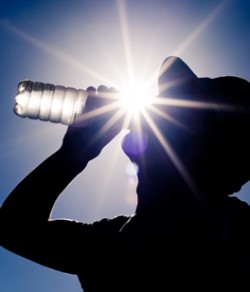 Earlier this year California rolled out a major update to the country’s flagship heat stress program; effective May 1, 2015, this FAQ can help explain how it will be enforced.
Earlier this year California rolled out a major update to the country’s flagship heat stress program; effective May 1, 2015, this FAQ can help explain how it will be enforced.
The rationale behind the update is this: mild heat illness can quickly become severe, leading to new elements in training, shade, water, preventative breaks, first aid response, acclimatization, and emergency procedures.
Plan Requirements
There must be a written plan to establish, implement and maintain heat illness protection. It must be in in English and any other language understood by most employees, such as Spanish. Make this plan a chapter of your Injury Illness Prevention Plan (IIPP) and make it easily accessible on the worksite. This provision includes tablet and smart phone viewing of the Heat Illness Plan.
Shade
The most obvious change to the requirement is the temperature; mandatory shade is now 80°F, a five- degree drop. Keep in mind, this is the worksite temperature. Be aware of the predicted temperature but also check the temperature at work.
Furthermore, shade must be easy to reach and use. Don’t designate shaded areas where employees have to cross traffic or waterways; sit next to portable toilets, on wet ground; or too close to bushes or branches.
“Cool down” rests are now preventative, as employers need to encourage breaks to prevent overheating. Monitor and ask employees if they have any heat illness symptoms. Instruct them to stay in the shade until symptoms disappear and immediately provide first aid and call 9-1-1.
Water
Potable water now has to be refreshing, fresh, pure, and cooler than the surrounding temperature. Check for discouraging odors, use clean containers, and use approved and tested sources (municipal water is good, untested wells are not). If using hoses and other connections, make sure the manufacturer’s label indicates approved use.
Cal/OSHA warns that inspectors will question the placement of the water container on the worksite. Water containers are smaller than shade structures and can be placed closer than shade. Consider each issue separately: shade and water.
High Heat
Changes to high heat procedures – when the temperature reaches 95°F – include observation techniques that designate who calls 9-1-1, pre-shift meetings, and preventative cool-down rest periods.
While the previous regulation required that employees be observed for heat illness symptoms, four methods are described. The first allows for the supervisor to directly observe small groups of 20 workers or less. For more employees, a buddy system can be established of employees responsible for observing each other. For lone workers, the employer may regularly and frequently check in with them by phone or radio. The fourth, “other effective means of observation,” makes the employer explain the method in use and defend how it is effective.
While all employees can call 9-1-1, the new regulation wants employers to designate a small number of employees per crew to be responsible for calling emergency medical services when necessary.
Pre-shift meetings with supervisors and employees are included in the high heat procedures. These can be merely brief reminders on heat stress topics.
A 10-minute, preventative, cool-down rest period is mandatory every two hours. These breaks can coincide with other scheduled breaks without having to be taken separately. Just be prepared to keep up these breaks to properly coincide with any overtime work, take a 10-minute break at the end of the eighth hour and another break at the end of the tenth hour.
Emergency Response
If emergency response procedures aren’t already established in your IIPP, they are now a specific requirement of the heat stress program.
For instance, the plan must take into account any remote locations and their challenges: difficult access for emergency responders, needed steps to transport employees safely to the emergency responders, and ensuring workers have a map or detailed directions for the worksite location.
Acclimatization
Acclimatization must be part of the plan for new employees in their first 14 days, and all employees during a heat wave. This means taking extra steps to closely observe employees and lessen employee workload.
Training
All of these heat stress components rely heavily on everyone knowing the symptoms and basic first aid responses. With these regulatory updates, it’s now clear that employees need to know about employer responsibilities: providing water, shade, cool-down rests, and first aid access. Employers have to teach workers their rights and why acclimatization is important.
